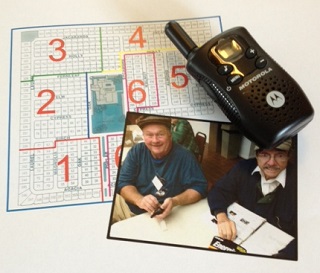Building a Neighborhood Emergency Preparedness Team
UPDATED SEPTEMBER 9, 2018.
Yes, it’s fun to pull together survival kits for yourself and family members. For some of us, getting more and better survival gear turns out to be a sort of addiction! (A healthy addiction, we believe.) And creating family plans is satisfying, even though they require constant updating.
But once your immediate household is organized, what then?
When the emergency hits, are your neighbors going to be knocking on your door, looking for help?
They may. And you may not want or be able to help them.
The only way to solve this problem is to encourage neighbors and co-workers to be as prepared as you are!
We have devoted a lot of our time over the past 15 years to helping our neighbors get prepared, trained and organized. If you’ve been reading our Advisories, you know about some of what we’ve done.
Now we’re adding one more piece to the puzzle.
Building a Neighborhood Emergency Preparedness Team — getting more attention.
About 3 years ago, we started a whole new section on building a neighborhood group. Here’s how we started that section:
- Step One was to pull together all our original material on team-building that we’ve created for Emergency Plan Guide readers. That list starts at the bottom of this post.
- Step Two was to reach out to other organizations around the U.S. for their best ideas. In fact, many of our blog posts already link to others’ stories and skills, and we’ve added more and more.
- Step Three was to solicit specific input for Emergency Plan Guide readers. We continue to do this, and you can help by referring us to people or sources you know, or by suggesting a topic you’d like to know more about. We’ll track down and share the best info we can find!
Let’s start with resources for those people who have already made the commitment to starting or building a neighborhood group.
We assume that as the leader, you will have found a way to get formal CERT training for yourself. Not all members of your team may get training, but you need the framework and vocabulary of CERT so that your group can work effectively together and with local first responder teams.
So to start with Step One for building a neighborhood emergency preparedness team . . .
. . .here is a list of some original material from the Emergency Plan Guide collection. Most of this is ready for download as is, with the first couple of handbooks available for purchase. We hope you’ll find what you need for YOUR group!
Comprehensive training manuals
- The Neighborhood Disaster Survival Series — our 4 books aimed at building groups in different kinds of neighborhoods. Each book is over 100 pages filled with specific steps and suggestions based on 15 years of growing our own group. The books are at Amazon, in ebook (downloadable) or paperback.
- Meeting Ideas — A collection of meeting ideas, with a list of what you’ll need, how best to schedule the activities, what to watch out for, etc. $10 at Amazon. Get more details by clicking the link.
Stand-alone subjects for training or discussion
- UPDATED! How to Recruit Volunteers — We just updated this list. Download your copy now!
- How to Hold a Great Meeting — Event-planning basics that you’re probably familiar with, but that can help others on your team get up to speed. Since we started our own group, we’ve been able to provide a great overhead projection and sound system for our guest speakers. That helps, as long as you have some skilled audio-visual people on hand!
- Finding Leaders — Every member of your team needs to be able to step up to lead. After all, when the emergency hits, you can’t be sure who will be on hand.
- Active Shooter Event — Worth a discussion, particularly given recent developments here and abroad.
- For more, just click on NEIGHBORHOOD in the category listing in the sidebar to the right.
Possible group investments
- Walkie-Talkies for Group Communications — We use our hand-held radios (walkie-talkies) every month and for many non-emergency events.
- Community Cache of Supplies — Read about our group’s decision in this regard.
- Financing Serious Emergency Equipment — These are items that take some real cash and consideration.
More to come! (Be sure to sign up to get our Advisories so you don’t miss anything!)
Virginia
Your Emergency Plan Guide Team
P.S. Step Two for Building a Neighborhood Emergency Preparedness Team is to reach out to other organizations. Just last week you saw the results of some of our outreach when we wrote about the Lamorinda California CERT team’s upcoming meeting. Please share what YOUR group is doing!


